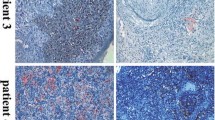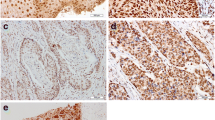Abstract
Background
Neoadjuvant chemotherapy (NAC) is an important treatment strategy for cervical cancer; however, few predictive markers of the response to NAC exist. Aldehyde dehydrogenase 1 (ALDH1), a cancer stem cell marker, is associated with chemoresistance in a variety of cancers. This study attempted to investigate the value of ALDH1 as a predictive marker of chemosensitivity and its prognostic value in cervical cancer patients treated with NAC.
Methods
Immunohistochemistry was used to evaluate ALDH1 expression in matched pre- and post-NAC tumor samples from 52 patients with cervical cancer. Kaplan–Meier analysis and a Cox proportional hazards regression model were applied to determine overall survival (OS) and disease-free survival (DFS).
Results
Fourteen patients (26.9 %) had ALDH1-positive tumors pre-NAC, and ALDH1 expression pre-NAC was significantly associated with a low clinical chemotherapy response rate and clinical non-response. Twenty-two patients (42.3 %) had ALDH1-positive tumors post-NAC, and ALDH1 expression post-NAC was associated with poor DFS and OS (both p = 0.004). Multivariate analysis revealed that ALDH1 expression post-NAC was an independent prognostic factor for OS (hazard ratio 3.513; p = 0.033). Moreover, we observed that ALDH1 expression was increased after NAC in 18 patients (36.7 %). Increased levels of ALDH1 expression after NAC predicted poor DFS and OS (p = 0.013 and p = 0.08, respectively).
Conclusions
Our findings suggest that ALDH1 expression pre-NAC may be a predictive marker for response to NAC, and ALDH1 expression post-NAC could be a prognostic marker for cervical cancer.

Similar content being viewed by others
References
Jemal A, Bray F, Center MM, Ferlay J, Ward E, Forman D. Global cancer statistics. CA Cancer J Clin. 2011;61(2):69–90.
Wiebe E, Denny L, Thomas G. Cancer of the cervix uteri. Int J Gynaecol Obstet. 2012;119:S100–09.
Pareja R, Rendon GJ, Sanz-Lomana CM, Monzon O, Ramirez PT. Surgical, oncological, and obstetrical outcomes after abdominal radical trachelectomy: a systematic literature review. Gynecol Oncol. 2013;131(1):77–82.
Marchiole P, Tigaud JD, Costantini S, et al. Neoadjuvant chemotherapy and vaginal radical trachelectomy for fertility-sparing treatment in women affected by cervical cancer (FIGO stage IB-IIA1). Gynecol Oncol. 2011;122(3):484–90.
Chen H, Liang C, Zhang L, Huang S, Wu X. Clinical efficacy of modified preoperative neoadjuvant chemotherapy in the treatment of locally advanced (stage IB2 to IIB) cervical cancer: randomized study. Gynecol Oncol. 2008;110(3):308–15.
Buda A, Fossati R, Colombo N, et al. Randomized trial of neoadjuvant chemotherapy comparing paclitaxel, ifosfamide, and cisplatin with ifosfamide and cisplatin followed by radical surgery in patients with locally advanced squamous cell cervical carcinoma: the SNAP01 (Studio Neo-Adjuvante Portio) Italian Collaborative Study. J Clin Oncol. 2005;23(18):4137–45.
Ye Q, Yuan HX, Chen HL. Responsiveness of neoadjuvant chemotherapy before surgery predicts favorable prognosis for cervical cancer patients: a meta-analysis. J Cancer Res Clin Oncol. 2013;139(11):1887–98.
Wen H, Wu X, Li Z, et al. A prospective randomized controlled study on multiple neoadjuvant treatments for patients with stage IB2 to IIA cervical cancer. Int J Gynecol Cancer. 2012;22(2):296–302.
Gong L, Lou JY, Wang P, Zhang JW, Liu H, Peng ZL. Clinical evaluation of neoadjuvant chemotherapy followed by radical surgery in the management of stage IB2-IIB cervical cancer. Int J Gynaecol Obstet. 2012;117(1):23–6.
Alison MR, Guppy NJ, Lim SM, Nicholson LJ. Finding cancer stem cells: are aldehyde dehydrogenases fit for purpose? J Pathol. 2010;222(4):335–44.
Bortolomai I, Canevari S, Facetti I, et al. Tumor initiating cells: development and critical characterization of a model derived from the A431 carcinoma cell line forming spheres in suspension. Cell Cycle. 2010;9(6):1194–206.
Casagrande N, De Paoli M, Celegato M, et al. Preclinical evaluation of a new liposomal formulation of cisplatin, lipoplatin, to treat cisplatin-resistant cervical cancer. Gynecol Oncol. 2013;131(3):744–52.
Rao QX, Yao TT, Zhang BZ, et al. Expression and functional role of ALDH1 in cervical carcinoma cells. Asian Pac J Cancer Prev. 2012;13(4):1325–31.
Liu SY, Zheng PS. High aldehyde dehydrogenase activity identifies cancer stem cells in human cervical cancer. Oncotarget. 2013;4(12):2462–75.
Tanei T, Morimoto K, Shimazu K, et al. Association of breast cancer stem cells identified by aldehyde dehydrogenase 1 expression with resistance to sequential Paclitaxel and epirubicin-based chemotherapy for breast cancers. Clin Cancer Res. 2009;15(12):4234–41.
Avoranta ST, Korkeila EA, Ristamaki RH, et al. ALDH1 expression indicates chemotherapy resistance and poor outcome in node-negative rectal cancer. Hum Pathol. 2013;44(6):966–74.
Minato T, Yamamoto Y, Seike J, et al. Aldehyde dehydrogenase 1 expression is associated with poor prognosis in patients with esophageal squamous cell carcinoma. Ann Surg Oncol. 2013;20(1):209–17.
Therasse P, Arbuck SG, Eisenhauer EA, et al. New guidelines to evaluate the response to treatment in solid tumors. European Organization for Research and Treatment of Cancer, National Cancer Institute of the United States, National Cancer Institute of Canada. J Natl Cancer Inst. 2000;92(3):205–16.
Jin L, Shen Q, Ding S, Jiang W, Jiang L, Zhu X. Immunohistochemical expression of Annexin A2 and S100A proteins in patients with bulky stage IB-IIA cervical cancer treated with neoadjuvant chemotherapy. Gynecol Oncol. 2012;126(1):140–46.
Lax S, Schauer G, Prein K, et al. Expression of the nuclear bile acid receptor/farnesoid X receptor is reduced in human colon carcinoma compared to nonneoplastic mucosa independent from site and may be associated with adverse prognosis. Int J Cancer. 2012;130(10):2232–39.
Aomatsu N, Yashiro M, Kashiwagi S, et al. CD133 is a useful surrogate marker for predicting chemosensitivity to neoadjuvant chemotherapy in breast cancer. PloS One. 2012;7(9):e45865.
Choi CH, Song SY, Choi JJ, et al. Prognostic significance of VEGF expression in patients with bulky cervical carcinoma undergoing neoadjuvant chemotherapy. BMC Cancer. 2008;8:295.
Costa S, Terzano P, Bovicelli A, et al. CD44 isoform 6 (CD44v6) is a prognostic indicator of the response to neoadjuvant chemotherapy in cervical carcinoma. Gynecol Oncol. 2001;80(1):67–73.
Park JS, Jeon EK, Chun SH, et al. ERCC1 (excision repair cross-complementation group 1) expression as a predictor for response of neoadjuvant chemotherapy for FIGO stage 2B uterine cervix cancer. Gynecol Oncol. 2011;120(2):275–79.
Watari H, Kanuma T, Ohta Y, et al. Clusterin expression inversely correlates with chemosensitivity and predicts poor survival in patients with locally advanced cervical cancer treated with cisplatin-based neoadjuvant chemotherapy and radical hysterectomy. Pathol Oncol Res. 2010;16(3):345–52.
Januchowski R, Wojtowicz K, Zabel M. The role of aldehyde dehydrogenase (ALDH) in cancer drug resistance. Biomed Pharmacother. 2013;67(7):669–80.
Magni M, Shammah S, Schiro R, Mellado W, Dalla-Favera R, Gianni AM. Induction of cyclophosphamide-resistance by aldehyde-dehydrogenase gene transfer. Blood. 1996;87(3):1097–103.
Greaves M, Maley CC. Clonal evolution in cancer. Nature. 2012;481(7381):306–13.
Jordan CT, Guzman ML, Noble M. Cancer stem cells. N Engl J Med. 2006;355(12):1253–61.
Sakakibara M, Fujimori T, Miyoshi T, et al. Aldehyde dehydrogenase 1-positive cells in axillary lymph node metastases after chemotherapy as a prognostic factor in patients with lymph node-positive breast cancer. Cancer. 2012;118(16):3899–910.
Gong C, Yao H, Liu Q, et al. Markers of tumor-initiating cells predict chemoresistance in breast cancer. PloS One. 2010;5(12):e15630.
Dylla SJ, Beviglia L, Park IK, et al. Colorectal cancer stem cells are enriched in xenogeneic tumors following chemotherapy. PloS One. 2008;3(6):e2428.
Acknowledgment
The authors would like to thank Dr. Bo Wang for his technical support. This work was supported by the National Natural Science Foundation of China (30672221, 30872743).
Conflict of interest
Qingsheng Xie, Jinxiao Liang, Qunxian Rao, Xiaofei Xie, Ruixin Li, Yunyun Liu, Hui Zhou, Jingjing Han, Tingting Yao, and Zhongqiu Lin declare that they have no actual or potential competing financial interests.
Author information
Authors and Affiliations
Corresponding authors
Electronic supplementary material
Below is the link to the electronic supplementary material.
Fig. S1
Identification and grading of ALDH1-positive tumor cells using immunohistochemistry. Representative images of (A) cervical cancer tissues with an ALDH1 score of 0; (B) 1+; (C) 2+; (D) and 3+; original magnification ×400. ALDH1 staining was mainly localized to the cytoplasm of the tumor cells, though faint expression was also observed in the surrounding stromal and vascular areas of the tumour tissues. Supplementary material 1 (TIFF 1985 kb)
Fig. S2
Kaplan-Meier 5-year disease-free survival (DFS) and 5-year overall survival (OS) curves for patients with cervical cancer. (A and B) Patients with ALDH1-positive tumors pre-NAC tended to have poorer DFS and OS, though this difference was not significant. (C and D) Patients who responded to NAC had significantly better DFS and OS. (E and F) Patients with ALDH1-positive tumors post-NAC had poorer 5-year DFS and 5-year OS. (G and H) Patients with increased ALDH1 expression after NAC had poorer DFS and OS than non-increased ones; however, this effect was not significant for DFS. Supplementary material 2 (TIFF 984 kb)
Rights and permissions
About this article
Cite this article
Xie, Q., Liang, J., Rao, Q. et al. Aldehyde Dehydrogenase 1 Expression Predicts Chemoresistance and Poor Clinical Outcomes in Patients with Locally Advanced Cervical Cancer Treated with Neoadjuvant Chemotherapy Prior to Radical Hysterectomy. Ann Surg Oncol 23, 163–170 (2016). https://doi.org/10.1245/s10434-015-4555-7
Received:
Published:
Issue Date:
DOI: https://doi.org/10.1245/s10434-015-4555-7




